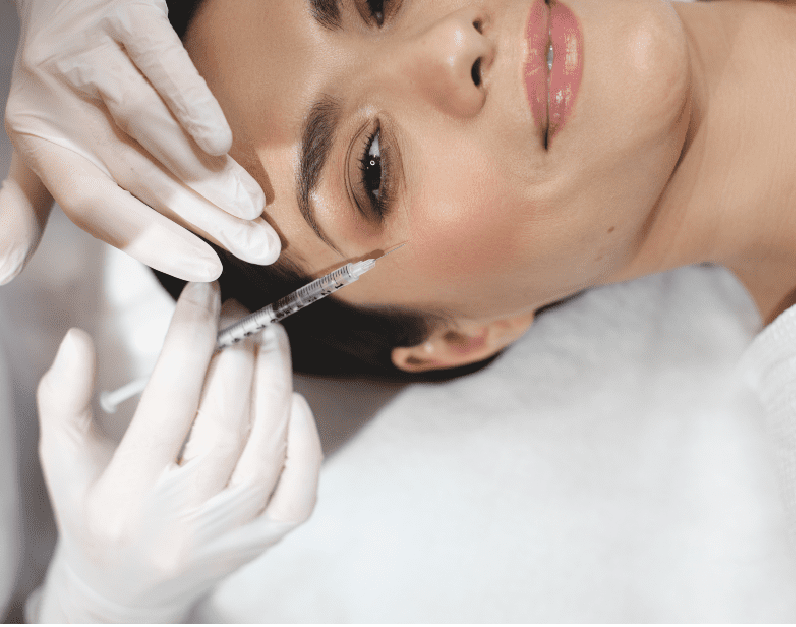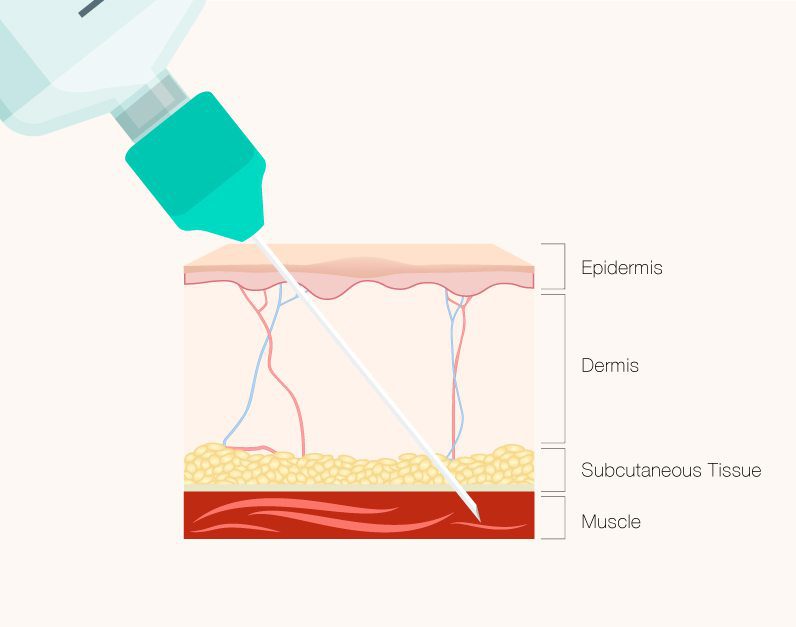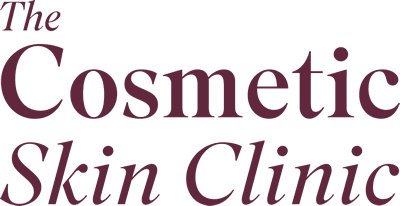The following will help you understand what happens when BOTOX injections are administered to areas of the face.
Arriving at the clinic
The clinic will check you in and give you any documentation to read that is relating to the procedure. The consultation with your treating practitioner would have covered all of this information before.
Consenting to your Botox treatment
Once inside the treatment room, the practitioner will recap on the treatment to make sure you are clear about the procedure and answer any further questions you may have. A consent form will then be signed.

Preparing the face for treatment
Your practitioner will then ask you to make a series of facial expressions. Some practitioners mark the areas on your face that will be injected into; some do not. It is an individual preference.
At this point, the sites of the injections will be cleaned using a non-alcoholic cleanser.
BOTOX injections do not normally require the use of an anaesthetic (this comes in the form of a cream, which is smoothed into the area of the skin to be injected) as the needles are so small and the injections are administered very quickly.
How is Botox administered?
Your practitioner will have a detailed knowledge of the face, including the skin’s thickness and the type of muscle to be found at different sites in the face. They will use this knowledge to judge the location of the muscle into which the Botox injection will go and the depth to which the needle must be inserted.
How deep is Botox injected?
One of the most common mistakes that untrained practitioners do is not injecting Botox deeply enough or injecting it too superficially. Botox must be injected into the superficial layers of the skin in some areas, while in others, it needs to be injected deeply. One example is the masseter muscle near the mouth. If a practitioner doesn’t inject this muscle deeply enough, patients can end up with an uneven or unbalanced smile. This is why it is so important to choose a clinic with excellent safety standards and trained staff that will know how deep should botox be injected.
How Botulinum Toxin works
BOTOX relaxes muscles by attaching itself to nerve endings that are connected to the muscles in question. This blocks the transmission of chemicals that send their specific messages to muscles from the brain telling them to move. When this message is blocked, muscles in the face will not crease up, and the skin on the surface will remain smooth, not wrinkled.
Because Botulinum Toxin is injected directly into the muscle, nearby areas do not have the nerve-blocking effects. Treatment is not long-lasting as nerves will grow new connections over time.
The injections used during anti-wrinkle treatments are administered both directly into the muscle (intramuscular) and into the area between the skin and the muscle (subcutaneous). These injections are felt as tiny pin pricks.

Each session will be different, depending on the treatment that has been agreed; however, an average session could involve about five injections either side of the forehead and maybe three injections around each eye.
Pre-injection BOTOX preparation
Botulinum Toxin is delivered to most clinics as dry powder. This is often in the form of 50 or 100 unit vials. The powdered substance is then diluted appropriately with saline solution.
It should be noted that it is the total number of units received, rather than the volume of BOTOX solution, that should be considered when working out how much BOTOX you are receiving.
Practitioners will vary on how much they dilute their BOTOX.
Botox Needles
Many patients often worry about the needles that Botox practitioners use. Some fear that they will be large and will cause significant discomfort. But this couldn’t be further from the truth. Trained practitioners used medically approved fine needles that are similar in thickness to those that Type 1 diabetics use every day when they inject themselves. These ultra-fine needles ensure expert precision while guaranteeing that pain and bruising will be minimised in the injection process.
The doses
The amount of Botulinum Toxin that is injected during each visit will vary from person to person. The number of doses delivered is tailored according to:
- Areas to be injected
- Depth of wrinkles
- Mass of the muscle targeted
After the Botox injection
BOTOX injections typically take only a few minutes, with the session lasting less than a standard lunch break.
Before you leave the clinic you will be advised to avoid lying down for around 4 hours and to refrain from any exercise or activity that is over strenuous for the rest of the day. Other aftercare advice includes not booking a facial or similar beauty treatment for at least 1 week. Explore our Botox Aftercare FAQs blog for the complete list of questions and tips on after Botox care.
What happens next?
BOTOX normally begins to affect the way facial muscles relax after about 3 days. You should begin to see noticeable changes in the smoothness of your skin within a week. The full effects of BOTOX won’t be seen until 2 weeks after treatment.
Once the effects have worn off, it is perfectly safe to arrange for further Botox top-up treatments, usually after 3-4 months.
If you have any questions about how BOTOX is administered, or anything else relating to non-invasive cosmetic treatments, please contact us by phoning 0343 253 8240 or filling out a contact form.
Finding a Botox clinic near me?
At The Cosmetic Skin Clinic, we have convenient Botox clinic locations in London and Buckinghamshire. Find out more about treatments at any of our clinic locations by filling in our online form.
The Cosmetic Skin Clinic in London is situated near Baker Street, Oxford Circus and Bond Street tube stations. We’re also conveniently located and within a quick train ride from Paddington or Kings Cross St Pancras Train Stations.
The Cosmetic Skin Clinic in Stoke Poges, Buckinghamshire is located near Gerrards Cross (Chiltern Railway) and Slough’s (First Great Western) station. If you’re travelling with your own car, please know that the M25, M4, M40 and A40 roads, makes it very easy to reach from Wembley, Richmond, Kingston upon Thames, Beaconsfield, Windsor and from the Surrey area.




















